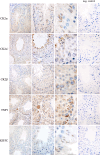Protein kinase CK2 and new binding partners during spermatogenesis
- PMID: 20524034
- PMCID: PMC11115564
- DOI: 10.1007/s00018-010-0412-9
Protein kinase CK2 and new binding partners during spermatogenesis
Abstract
Protein kinase CK2 is an ubiquitously expressed enzyme that is absolutely necessary for the survival of cells. Besides the holoenzyme consisting of the regulatory β-subunit and the catalytic α- or α'-subunit, the subunits exist in separate forms. The subunits bind to a number of other cellular proteins. We show the expression of individual subunits as well as interaction with the transitional nuclear protein TNP1 and with the motor neuron protein KIF5C during spermatogenesis. TNP1 is a newly identified binding partner of the α-subunit of CK2. CK2α and KIF5C were found in late spermatogenesis, whereas CK2β and TNP1 were found in early spermatogenesis. CK2α, CK2α', TNP1, and KIF5C were detected in the acrosome of spermatozoa, while CK2β was detectable in the mid-piece. Combinations of CK2 subunits might determine interactions with other proteins during spermatogenesis. KIF5C as a kinesin motor neuron protein is probably involved in the redistribution of proteins during spermatogenesis.
Figures






Similar articles
-
Differential localization of alpha' and beta subunits of protein kinase CK2 during rat spermatogenesis.Cell Tissue Res. 2009 Oct;338(1):139-49. doi: 10.1007/s00441-009-0847-1. Epub 2009 Aug 27. Cell Tissue Res. 2009. PMID: 19711102
-
The kinesin I family member KIF5C is a novel substrate for protein kinase CK2.Biochem Biophys Res Commun. 2008 Oct 17;375(2):179-83. doi: 10.1016/j.bbrc.2008.07.107. Epub 2008 Aug 3. Biochem Biophys Res Commun. 2008. PMID: 18682247
-
KIF5C: a new binding partner for protein kinase CK2 with a preference for the CK2alpha' subunit.Cell Mol Life Sci. 2009 Jan;66(2):339-49. doi: 10.1007/s00018-008-8478-3. Cell Mol Life Sci. 2009. PMID: 19011756 Free PMC article.
-
Toward selective CK2alpha and CK2alpha' inhibitors: Development of a novel whole-cell kinase assay by Autodisplay of catalytic CK2alpha'.J Pharm Biomed Anal. 2016 Mar 20;121:253-260. doi: 10.1016/j.jpba.2016.01.011. Epub 2016 Jan 8. J Pharm Biomed Anal. 2016. PMID: 26786382
-
Protein kinase CK2 in breast cancer: the CK2β regulatory subunit takes center stage in epithelial plasticity.Cell Mol Life Sci. 2015 Sep;72(17):3305-22. doi: 10.1007/s00018-015-1929-8. Epub 2015 May 20. Cell Mol Life Sci. 2015. PMID: 25990538 Free PMC article. Review.
Cited by
-
TCTEX1D4 interactome in human testis: unraveling the function of dynein light chain in spermatozoa.OMICS. 2014 Apr;18(4):242-53. doi: 10.1089/omi.2013.0133. Epub 2014 Mar 7. OMICS. 2014. PMID: 24606217 Free PMC article.
-
Inhibition of Protein Kinase CK2 Prevents Adipogenic Differentiation of Mesenchymal Stem Cells Like C3H/10T1/2 Cells.Pharmaceuticals (Basel). 2017 Feb 9;10(1):22. doi: 10.3390/ph10010022. Pharmaceuticals (Basel). 2017. PMID: 28208768 Free PMC article.
-
Sperm Differentiation: The Role of Trafficking of Proteins.Int J Mol Sci. 2020 May 24;21(10):3702. doi: 10.3390/ijms21103702. Int J Mol Sci. 2020. PMID: 32456358 Free PMC article. Review.
-
Improving effects of telmisartan on spermatogenic disorder induced by fractionated low-dose irradiation in mice.Int Urol Nephrol. 2023 Jun;55(6):1427-1439. doi: 10.1007/s11255-023-03601-5. Epub 2023 Apr 24. Int Urol Nephrol. 2023. PMID: 37093439
-
Kinesins in Mammalian Spermatogenesis and Germ Cell Transport.Front Cell Dev Biol. 2022 Apr 25;10:837542. doi: 10.3389/fcell.2022.837542. eCollection 2022. Front Cell Dev Biol. 2022. PMID: 35547823 Free PMC article. Review.
References
Publication types
MeSH terms
Substances
LinkOut - more resources
Full Text Sources

